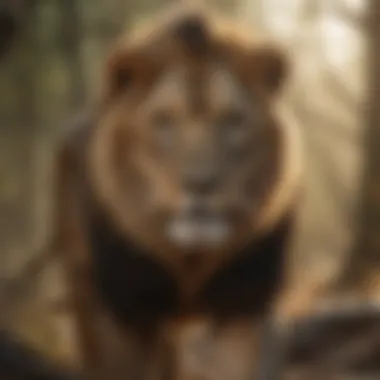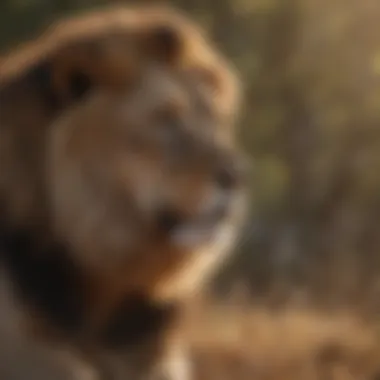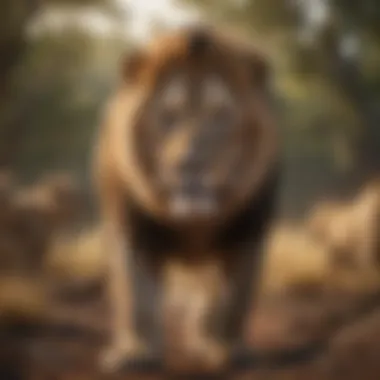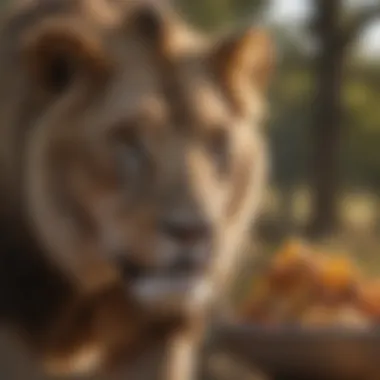Exploring the Intricate Hunting Tactics of Male Lions


Nature Topic Overview
Male lions' hunting behavior offers a captivating insight into the intricate dynamics of pride survival. Understanding the roles, strategies, and significance of male lions in securing food for the pride is crucial to unraveling the complexities of their hunting patterns and behaviors.
Fun Facts and Trivia
- Did you know that male lions are not the primary hunters in a pride? They often rely on the lionesses to hunt for food, showcasing the collaborative nature of pride dynamics.
- Male lions spend a majority of their time patrolling the pride's territory, defending it against intruders and potential threats, ensuring the safety of their pride members.
Wildlife Explorations
Exploring the ecosystem of male lions reveals fascinating interactions with other species. From the intricate social structures of meerkats to the stealthy movements of leopards, each wildlife encounter enriches our understanding of the interconnected web of predators in the African savannah.
Environmental Awareness
The conservation of lion populations is a critical aspect of preserving biodiversity. Through initiatives like land conservation and anti-poaching efforts, communities can contribute to safeguarding the natural habitats of these majestic creatures.
DIY Nature Activities
Engage children in hands-on learning with lion-inspired crafts and activities. From creating lion masks to organizing a 'roar like a lion' contest, these interactive projects foster a deeper connection with nature and wildlife. Encourage outdoor explorations that prompt children to observe and appreciate the natural world around them.
Preamble to Male Lions
Male lions are a fascinating subject, integral to the intricate dynamics of a pride. Their physiology, behaviors, and contributions set them apart within the pride's hierarchy. Understanding male lions is crucial for grasping the functionality of the pride as a whole. These majestic creatures exhibit distinct characteristics that influence not only their role in the pride but also the balance within the ecosystem.
Physiological Differences
Comparison to Female Lions
Male lions possess unique traits compared to their female counterparts, such as their impressive manes and larger physical stature. These differences play a pivotal role in defining their responsibilities within the pride. The mane serves both a protective and dominant function, signaling their status and strength. Understanding these distinctions provides insights into the intricate social structure of the pride.
Role in the Pride's Dynamics
The male lion's role within the pride's dynamics is multifaceted. They contribute to leadership, protection, and genetic diversity. Their position as the heads of pride influences not only mating privileges but also territorial control. By understanding their contributions, we can unravel the complexities of pride dynamics and the cooperation necessary for survival.
Social Structure
Hierarchy within the Pride
The hierarchy within a lion pride is crucial for maintaining order and efficiency. Male lions establish dominance through displays of strength and strategic alliances. By delving into the nuances of pride hierarchy, we gain insight into power dynamics and social behaviors. Understanding this structure is fundamental to comprehending the roles each member plays.


Collaborative Hunting
Collaborative hunting is a hallmark of lion behavior, showcasing their coordination and teamwork. Male lions play a key role in orchestrating successful hunts, utilizing their strength and experience. This cooperative strategy not only ensures the pride's sustenance but also fosters bonds among members. Exploring this hunting method offers a glimpse into the intricate social interactions within the pride.
Roles of Male Lions in Hunting
Male lions play a crucial role in hunting within the pride. Their strong physique and strategic capabilities make them essential for securing food for the group. Lions are skilled at coordinating hunts, using their strength to take down prey efficiently. The presence of male lions also acts as a deterrent to potential threats, ensuring the safety of the pride. Their hunting prowess not only provides nourishment for the group but also maintains the dominance and hierarchy within the pride. Understanding the roles of male lions in hunting illuminates the intricate dynamics of pride life.
Territorial Defense
Protecting the Pride's Domain
Protecting the pride's domain is a critical aspect of male lions' responsibilities. By safeguarding their territory, male lions ensure a stable and safe environment for the pride to thrive. This defensive strategy helps in maintaining control over resources and securing space for hunting and breeding. The territorial defense exhibited by male lions underscores their commitment to the pride's survival and well-being. While this task poses challenges, such as potential conflicts with neighboring prides, it remains a top priority for male lions in protecting their pride and ensuring its sustainability.
Challenges Faced
Male lions encounter various challenges in fulfilling their role of territorial defense. Competing prides, habitat encroachment, and human-wildlife conflicts pose significant threats to their domain. Balancing the need to defend their territory with external pressures requires strategic decision-making and vigilance. Overcoming these challenges is paramount for male lions to maintain their pride's safety and continuity. Despite the hurdles faced, male lions are resilient in their efforts to protect their pride, illustrating their unwavering dedication and adaptability.
Hunting Strategies
Ambush Techniques
Ambush techniques are a vital component of male lions' hunting strategies. By stealthily approaching their prey and launching precise attacks, male lions increase their hunting success rates. This method allows them to capitalize on the element of surprise, overpowering unsuspecting targets efficiently. Ambush techniques showcase the patience and calculated approach male lions employ in securing food for the pride. While this strategy requires careful planning and execution, its effectiveness in capturing prey underscores the strategic brilliance of male lions in the wild.
Coordinated Attacks
Coordinated attacks exemplify the collaborative nature of male lions in hunting. By working together seamlessly, male lions enhance their chances of a successful hunt. Coordinated efforts enable male lions to take down larger prey, showcasing their teamwork and communication skills. This strategic approach maximizes efficiency and minimizes risks during hunts. While coordinated attacks demand synchrony and unity among male lions, the benefits of shared effort and combined strength amplify their effectiveness in providing for the pride.
Food Provisioning
Securing Prey
Securing prey is a fundamental aspect of male lions' hunting duties. Male lions employ various tactics to capture and secure food for the pride. Their strength and hunting prowess enable them to overpower prey animals, ensuring a sustainable food source for the group. Securing prey requires agility and precision, traits that male lions hone through practice and experience. By consistently securing prey, male lions fulfill a critical role in meeting the pride's nutritional needs, contributing to the overall health and stability of the group.
Feeding Prioritization
Feeding prioritization is essential for maintaining harmony within the pride. Male lions display leadership by allowing lionesses and cubs to feed first, showcasing respect and care for the entire pride. This prioritization ensures that vulnerable members receive nourishment promptly, promoting unity and solidarity. Male lions exhibit a sense of responsibility in orchestrating feeding sessions, fostering a sense of community within the pride. By prioritizing the well-being of all pride members, male lions demonstrate their commitment to maintaining social bonds and support structures.
Importance of Male Lions' Hunting
Understanding the crucial role of male lions in hunting is paramount to comprehending the dynamics within a pride. The article delves deep into the intricate web of interactions and dependencies that revolve around the male lion's hunting behavior. From territorial defense to food provisioning, male lions play a pivotal role in ensuring the survival and prosperity of the entire pride. By exploring this topic, readers can gain a profound insight into the significance of male lions' hunting endeavors within their natural environment.


Survival of the Pride
Ensuring Nutritional Needs
A fundamental aspect of male lions' hunting behavior is their contribution to ensuring the nutritional requirements of the pride are met adequately. By actively engaging in hunting activities, male lions secure essential food sources for the entire pride, which is crucial for their survival and well-being. The ability of male lions to effectively hunt and provide food demonstrates their vital role in maintaining the health and sustainability of the pride. This characteristic underscores the importance of male lions' hunting efforts in upholding the balance and continuity of the pride's ecosystem.
Implications of Skewed Gender Ratio
The gender balance within a lion pride holds significant implications for its overall dynamics and functioning. A skewed gender ratio, particularly in favor of one gender, can lead to disruptions in the social structure and coordination of hunting activities within the pride. Understanding the effects of such imbalances is essential to grasp the complexities of pride dynamics. By analyzing the implications of skewed gender ratios, one can appreciate the delicate equilibrium required for a pride to thrive harmoniously. This aspect sheds light on the nuanced interplay between gender dynamics and communal interactions among pride members.
Social Dynamics
Bonding Through Collaboration
Collaborative hunting among male lions not only serves as a means of securing food but also strengthens the bonds and relationships within the pride. The act of working together towards a common goal fosters a sense of unity and cooperation among pride members, enhancing social cohesion. This collaborative effort illustrates the synergy that exists within the pride, emphasizing the interconnectedness of its constituents. By emphasizing the significance of bonding through collaboration, this article elucidates the intricate social tapestry that characterizes male lion prides.
Influence on Offspring
The influence of male lions extends beyond hunting prowess to encompass a direct impact on the offspring within the pride. Through interactions, play, and role modeling, male lions shape the behavior and development of young cubs, imparting essential skills for their future survival. This influence highlights the role of male lions in grooming the next generation of pride members and perpetuating a legacy of survival strategies. Understanding the profound effect of male lions on offspring instills a deeper appreciation for their integral role in shaping the social dynamics and sustainability of the pride.
Challenges and Threats
As we delve into the intricate world of male lions' hunting behavior, it is crucial to understand the challenges and threats that these majestic creatures face. The survival of the pride hinges on how they navigate through various obstacles in their environment. Ranging from human-wildlife conflicts to environmental pressures, these challenges shape the dynamics of the ecosystem where male lions reside. By shedding light on these challenges, we gain a deeper appreciation for the resilience and adaptability of male lions in the face of adversity.
Human-Wildlife Conflict
Poaching Risks
Delving deeper into the realm of human-wildlife conflict, one significant aspect that poses a grave threat to male lions is poaching. The illicit act of poaching targets these magnificent beasts for various reasons, ranging from trophy hunting to the illegal wildlife trade. Poaching not only disrupts the delicate balance of the ecosystem but also endangers the very existence of male lions. The clandestine nature of poaching operations makes it a formidable foe for conservation efforts, necessitating stringent measures to combat this heinous practice.
Habitat Encroachment
Another critical aspect of human-wildlife conflict that significantly impacts male lions is habitat encroachment. As human populations expand and encroach upon the natural habitats of these apex predators, territorial conflicts arise, leading to heightened tensions. The shrinking of lion habitats not only restricts their movements but also exposes them to increased risks of confrontation with humans. Mitigating habitat encroachment is vital to safeguarding the well-being of male lions and preserving the delicate ecosystem they inhabit.
Environmental Pressures
Impact on Prey Population
The impact of environmental pressures on prey populations directly influences the hunting behavior of male lions. Fluctuations in prey abundance due to various environmental factors can strain the food resources available to male lions, affecting their hunting success. Understanding the intricate interplay between environmental changes and prey populations is essential for conserving the delicate balance of the ecosystem. By analyzing the impact on prey populations, we gain valuable insights into the interconnectedness of species within the ecosystem.
Climate Change Effects


Climate change exerts a significant influence on the habitats of male lions, posing unforeseen challenges to their hunting behavior. Shifts in climate patterns can disrupt the accustomed hunting grounds of male lions, forcing them to adapt to changing environmental conditions. The ripple effects of climate change cascade through the ecosystem, potentially altering prey distribution and availability. By grasping the nuances of climate change effects, we grasp the urgency of addressing environmental conservation to secure the future of male lions and their ecosystem.
Conservation Efforts
Community Initiatives
Livelihood Programs
In the realm of conservation, livelihood programs emerge as a beacon of hope for both communities and wildlife. These programs aim to provide sustainable income opportunities for local residents while promoting coexistence with nature. Their key characteristic lies in fostering economic development that aligns with conservation goals, offering alternative livelihoods that reduce dependency on activities harmful to the environment. Amidst the nuanced landscape of conservation efforts, livelihood programs stand out as a valuable tool in empowering communities to become stakeholders in wildlife conservation.
Education on Wildlife Protection
Education on wildlife protection serves as a cornerstone of fostering a culture of conservation within communities. This aspect emphasizes the importance of raising awareness and imparting knowledge about the significance of protecting wildlife and their habitats. Its key characteristic lies in its ability to instill a sense of responsibility and stewardship towards the environment. By incorporating education on wildlife protection into conservation initiatives, individuals are equipped with the information and skills necessary to actively contribute to conservation efforts, ensuring a sustainable future for both wildlife and communities.
Legislative Measures
Wildlife Protection Laws
The implementation of wildlife protection laws is essential in upholding conservation efforts and mitigating threats to biodiversity. These laws establish legal frameworks that govern the conservation and management of wildlife, setting clear guidelines for sustainable practices and prohibitions against harmful activities. A key characteristic of wildlife protection laws is their enforceability, ensuring that those who violate regulations are held accountable. By delving into wildlife protection laws, we uncover the foundational structure that supports conservation actions and safeguards the natural world.
Anti-Poaching Regulations
Anti-poaching regulations serve as a critical line of defense against the illegal exploitation of wildlife populations. These regulations are designed to deter and penalize activities such as poaching, trafficking, and habitat destruction, which pose significant threats to endangered species. A key characteristic of anti-poaching regulations is their proactive nature, aimed at preventing illicit activities before they cause irreparable harm. By exploring anti-poaching regulations, we recognize the indispensable role they play in protecting vulnerable species and conserving biodiversity.
Finale
Understanding the importance of the conclusion in this article is paramount. As we synthesize the information presented throughout, we grasp the critical role male lions play in the pride's survival. Their hunting behavior is not merely about securing food but also maintaining the delicate balance within the ecosystem. By examining their territorial defense, hunting strategies, and food provisioning, we gain a profound understanding of how male lions contribute to the overall cohesion and prosperity of the pride. It is clear that without the concerted efforts of these majestic creatures, the very fabric of the pride could unravel, underlining the significance of male lions' hunting behavior.
Significance in Ecosystem
Balancing Predator-Prey Dynamics
Exploring the intricate dance of balancing predator-prey dynamics unveils a crucial aspect of male lions' hunting behavior. By maintaining a sustainable equilibrium between prey populations and predator numbers, male lions prevent ecological imbalance. This delicate balance ensures the health of the ecosystem, showcasing the adaptability and resilience of these apex predators in their natural habitat. The interplay between predator and prey elucidates the intricate web of life, shedding light on the nuanced relationships that govern the wilderness.
Interconnectedness of Species
Delving into the interconnectedness of species reveals a tapestry of interactions where each thread is vital to the whole. Male lions' hunting behavior underscores their role not just as predators but as integral components of a complex ecosystem. Their interactions with prey species, vegetation, and other predators illustrate the ripple effect of their presence. This interconnected web of life showcases the depth of relationships in nature, emphasizing the coexistence and mutual dependence that characterizes life in the wild.
Call to Action
Support for Conservation Efforts
Advocating for support for conservation efforts forms a cornerstone of ensuring the preservation of male lions and their habitat. By backing initiatives that protect lion populations and their ecosystems, we invest in the future of these magnificent animals. Supporting conservation paves the way for sustainable cohabitation between humans and wildlife, promoting biodiversity and environmental harmony. It is through unified efforts that we can safeguard the legacy of male lions for generations to come.
Raising Awareness
Elevating awareness about male lions' hunting behavior is pivotal in fostering empathy and understanding towards these regal beasts. By shedding light on the challenges they face and the critical role they play in the ecosystem, we inspire a sense of stewardship and responsibility. Raising awareness not only educates the public but also empowers individuals to take action towards protecting these majestic creatures. Through informed outreach and education, we can foster a culture of coexistence and appreciation for the natural world.







